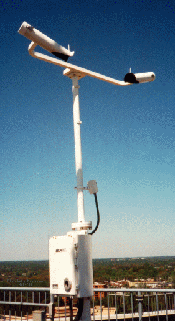Visibility & Day/Night Sensor
 The
Visibility and Day/Night Sensor, (the Visibility Sensor), measures visibility(see
below). It provides the means to calculate the current visibility level
automatically and show current day/night conditions. The Visibility Sensor
measures ambient visibility using the Forward Scatter Technique. This technique
transmits a flash of xenon(see below) light through a section of the atmosphere.
The atmosphere scatters the light. The scattered light level is measured to
detect the loss of light. An Extinction Coefficient is calculated from how
much light is received from the scattered xenon flash lamp light source.
This coefficient is then translated into a value of visibility.
The
Visibility and Day/Night Sensor, (the Visibility Sensor), measures visibility(see
below). It provides the means to calculate the current visibility level
automatically and show current day/night conditions. The Visibility Sensor
measures ambient visibility using the Forward Scatter Technique. This technique
transmits a flash of xenon(see below) light through a section of the atmosphere.
The atmosphere scatters the light. The scattered light level is measured to
detect the loss of light. An Extinction Coefficient is calculated from how
much light is received from the scattered xenon flash lamp light source.
This coefficient is then translated into a value of visibility.
The Visibility Sensor also computes a day or night indication as derived from an ambient light sensor. Both the Extinction Coefficient and day/night information are sent to and used by the Data Collection Package (DCP).
Visibility is a measure of the opacity of the atmosphere and is expressed in terms of the horizontal distance at which a person can see and identify specified objects. Xenon is a colorless, odorless, highly unreactive gas that is found in very small quantities in the atmosphere. Its atomic number is 54.